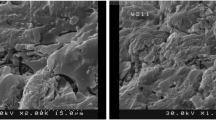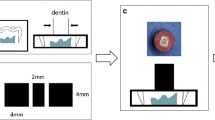Abstract
Objective
The aim of this study was to compare the effects of different pulse modes of Er:YAG laser on shear bond strength (SBS) of orthodontic brackets bonded with self-etching primers (SEP) and phosphoric acid etching.
Materials and methods
A total of 120 human mandibular third molars were randomly assigned to 3 groups of 40 specimens depending on the bonding procedure to be used. The groups were divided into two subgroups according to the pulse mode of the erbium-doped yttrium aluminum garnet (Er:YAG) laser irradiation as medium-short pulse (MSP) mode and quantum-square pulse (QSP) mode at 120 mJ, 10 Hz, 1.2 W. In each subgroup, the mesio- or distobuccal tooth surfaces were randomly assigned as experimental or control sides. After surface preparation with different modes of Er:YAG laser on experimental side, whole buccal tooth surfaces were treated with phosphoric acid etching or two different SEPs. Then metallic brackets were bonded with Transbond XT (3 M Unitek, Monrovia, CA, USA) or Kurasper F (Kuraray, Okayama, Japan). SBS values and the amount of adhesive remaining on the tooth after debonding were assessed. One-way analysis of variance (ANOVA) was used to evaluate the changes in mean SBS between groups resulting from laser etching, followed by post hoc test of Tukey.
Results
There were statistically significant differences between the experimental and control sides of all groups (p < 0.05).
Conclusion
Laser etching with QSP and MSP modes increases the SBS of metallic brackets and Er:YAG laser irradiation with QSP mode increases the SBS of SEPs.
Zusammenfassung
Ziel
In der Studie sollten die Effekte unterschiedlicher Er:YAG(“erbium-doped yttrium aluminum garnet”)-Laser-Pulsmodi auf die Scherhaftfestigkeit (“shear bond strength”, SBS) kieferorthopädischer Brackets untersucht werden, nach dem Kleben unter Verwendung selbstätzender Primer (“self-etching primers”, SEP) und Ätzung mit Phosphorsäure.
Material und Methoden
Insgesamt 120 humane dritte Molaren (Mandibula) wurden in 3 Gruppen à 40 Proben randomisiert, je nach verwendetem Klebe-Verfahren. Diese Gruppen wurden weiter unterteilt in jeweils 2 Untergruppen, je nach dem eingesetzten Pulsmodus des Er:YAGLasers: MSP(medium-short pulse)- bzw. QSP(quantum-square pulse)-Modus, 120 mJ, 10 Hz, 1,2 W. In jeder Untergruppe wurden die mesio- bzw. distobukkalen Zahnoberflächen randomisiert als experimentelle Seiten bzw. Kontrollseiten gewählt. Nach Oberflächenvorbereitung mit unterschiedlichen Er:YAG-Laser-Pulsmodi auf der experimentellen Seite wurden die gesamten bukkalen Zahnoberflächen mit Phosphorsäure oder mit 2 unterschiedlichen SEPs behandelt. Anschließend wurden Metall-Brackets mit Transbond XT (3 M Unitek, Monrovia, CA, USA) oder Kurasper F (Kuraray, Okayama, Japan) aufgebracht. Bestimmt wurden SBS-Werte und die Adhäsivmenge, die nach Debonding auf dem Zahn verblieben war. Zur Evaluierung der durch Laserätzung entstandenen SBS-Veränderungen zwischen den Gruppen dienten der Ein-Wege-ANOVA(“analysis of variance”)-Test und der anschließend durgeführte Post-hoc-Text nach Tukey.
Ergebnisse
Zwischen den experimentellen Seiten und den Kontrollseiten aller Gruppen bestanden statistisch signifikante Unterschiede (p < 0,05).
Schlussfolgerung
Eine Laserätzung in den Modi QSP und MSP verstärkt die SBS bei Metall-Brackets, und eine Er:YAG-Laser-Bestrahlung im QSP-Modus verstärkt die SBS bei Verwendung von SEPs.

Similar content being viewed by others
References
Ahrari F, Poosti M, Motahari P (2012) Enamel resistance to demineralization following Er: YAG laser etching for bonding orthodontic brackets. Dent Res J 9:472–477
Apel C, Meister J, Schmitt N et al (2002) Calcium solubility of dental enamel following sub-ablative Er:YAG and Er:YSGG laser irradiation in vitro. Lasers Surg Med 30:337–341
Apel C, Meister J, Ioana RS et al (2002) The ablation threshold of Er:YAG and Er:YSGG laser radiation in dental enamel. Lasers Med Sci 17:246–252
Arnold RW, Combe EC, Warford JH Jr (2002) Bonding of stainless steel brackets to enamel with a new self-etching primer. Am J Orthod Dentofacial Orthop 122:274–276
Basaran G, Ozer T, Berk N et al (2007) Etching enamel for orthodontics with an erbium, chromium:yttrium-scandium-gallium-garnet laser system. Angle Orthod 77:117–123
Berk N, Başaran G, Ozer T (2008) Comparison of sandblasting, laser irradiation, and conventional acid etching for orthodontic bonding of molar tubes. Eur J Orthod 30:183–189
Bishara SE, VonWald L, Laffoon JF et al (2001) Effect of a self-etch primer/adhesive on the shear bond strength of orthodontic brackets. Am J Orthod Dentofacial Orthop 119:621–624
Buyukyilmaz T, Usumez S, Karaman AI (2003) Effect of self-etching primers on bond strength-are they reliable? Angle Orthod 73:64–70
Chimello-Sousa DT, de Souza AE, Chinelatti MA et al (2006) Influence of Er:YAG laser irradiation distance on the bond strength of a restorative system to enamel. J Dent 34:245–251
Choe DP, Kipnis V, Singer J et al (1992) The effectiveness of the 308-NM excimer laser for pretreatment of enamel surface: a comparative study of shear bond strength between laser irradiation and acid etching. Am J Orthod Dentofacial Orthop 102:488
Costa AR, Correr AB, Puppin-Rontani RM et al (2011) Effects of thermocycling and light source on the bond strength of metallic brackets to bovine teeth. Braz Dent J 22:486–489
Cozean C, Arcoria CJ, Pelagalli J et al (1997) Dentistry for the 21st century? Erbium:YAG laser for teeth. J Am Dent Assoc 128:1080–1087
Eliades T, Brantley W (2000) The inappropriateness of conventional orthodontic bond strength assessment protocols. Eur J Orthod 22:13–23
Faltermeier A, Behr M, Müssig D (2007) A comparative evaluation of bracket bonding with 1-, 2-, and 3-component adhesive systems. Am J Orthod Dentofacial Orthop 132:144 e1–5
Finnema KJ, Özcan M, Post WJ et al (2010) In-vitro orthodontic bond strength testing: a systematic review and meta-analysis. Am J Orthod Dentofacial Orthop 137:615–622
Fox NA, McCabe J, Buckley J (1994) A critique of bond strength testing in orthodontics. J Orthod 21:33–43
Fernandez L, Canut JA (1999) In vitro comparison of the retention capacity of new aesthetic brackets. Eur J Orthod 21:71–77
Hale GM, Querry MR (1973) Optical constants of water in the 200-nm to 200-microm wavelength region. Appl Opt 12:555–563
Hossain M, Nakamura Y, Kimura Y et al (2000) Caries-preventive effect of Er: YAG laser irradiation with or without water mist. J Clin Laser Med Surg 18:61–65
Hossain M, Nakamura Y, Tamaki Y et al (2003) Atomic analysis and knoop hardness measurement of the cavity floor prepared by Er, Cr:YSGG laser irradiation in vitro. J Oral Rehabil 30:515–521
http://www.fotona.com/media/objave/priponke/brochurelightwalker_8_pages_v7_small.pdf
Iijima M, Ito S, Yuasa T et al (2008) Bond strength comparison and scanning electron microscopic evaluation of three orthodontic bonding systems. Dent Mater J 27:392–399
J-f Liu, Liu Y, Stephen HC-Y (2006) Optimal Er: YAG laser energy for preventing enamel demineralization. J Dent 34:62–66
Martinez-Insua A, Da Silva Dominguez L, Rivera FG et al (2000) Differences in bonding to acid-etched or Er:YAG-laser-treated enamel and dentin surfaces. J Prosthet Dent 84:280–288
O’Brien K, Watts D, Read M (1988) Residual debris and bond strength-Is there a relationship? Am J Orthod Dentofacial Orthop 94:222–230
Oliver R (1988) The effect of different methods of bracket removal onthe amount of residual adhesive. Am J Orthod Dentofacial Orthop 93:196–200
Ozer T, Basaran G, Berk N (2008) Laser etching of enamel for orthodontic bonding. Am J Orthod Dentofacial Orthop 134:193–197
Raji SH, Birang R, Majdzade F et al (2012) Evaluation of shear bond strength of orthodontic brackets bonded with Er-YAG laser etching. J Dent Res 9:288–293
Reynolds IR (1975) A review of direct orthodontic bonding. Br J Orthod 2:171–178
Sagir S, Usumez A, Ademci E, et al. (2013) Effect of enamel laser irradiation at different pulse settings on shear bond strength of orthodontic brackets. Angle Orthod. [Epub ahead of print]
Scougall Vilchis RJ, Yamamoto S, Kitai N et al (2009) Shear bond strength of orthodontic brackets bonded with different self-etching adhesives. Am J Orthod Dentofacial Orthop 136:425–430
Sundfeld RH, de Oliveira CH, da Silva AM et al (2005) Resin tag length of one-step and self-etching adhesives bonded to unground enamel. Bull Tokyo Dent Coll 46:43–49
Tanji EY, Matsumoto K, Eduardo CP (1997) Scanning electron microscopic observations of dentin surface conditioned with the Er: YAG laser. Deuts Gesellschaft Laser Newsletter 8:6
Türköz Ç, Ulusoy Ç (2012) Evaluation of different enamel conditioning techniques for orthodontic bonding. Korean J Orthod 42:32–38
Urabe H, Rossouw PE, Titley KC et al (1999) Combinations of etchants, composite resins, and bracket systems: an important choice in orthodontic bonding procedures. Angle Orthod 69:267–275
Usumez S, Orhan M, Usumez A (2002) Laser etching of enamel for direct bonding with an Er, Cr:YSGG hydrokinetic laser system. Am J Orthod Dentofacial Orthop 122:649–656
Von Fraunhofer J, Allen D, Orbell G (1993) Laser etching of enamel for direct bonding. Angle Orthod 63:73–76
Author information
Authors and Affiliations
Corresponding author
Ethics declarations
Conflict of interest
M. Akin, I. Veli, E.A. Erdur, S. Aksakalli, and Tancan Uysal state that there are no conflicts of interest. The accompanying manuscript does not include studies on humans or animals.
Additional information
Prof. Dr. Tancan Uysal.
Rights and permissions
About this article
Cite this article
Akin, M., Veli, I., Erdur, E.A. et al. Different pulse modes of Er:YAG laser irradiation: effects on bond strength achieved with self-etching primers. J Orofac Orthop 77, 151–159 (2016). https://doi.org/10.1007/s00056-016-0019-3
Received:
Accepted:
Published:
Issue Date:
DOI: https://doi.org/10.1007/s00056-016-0019-3




